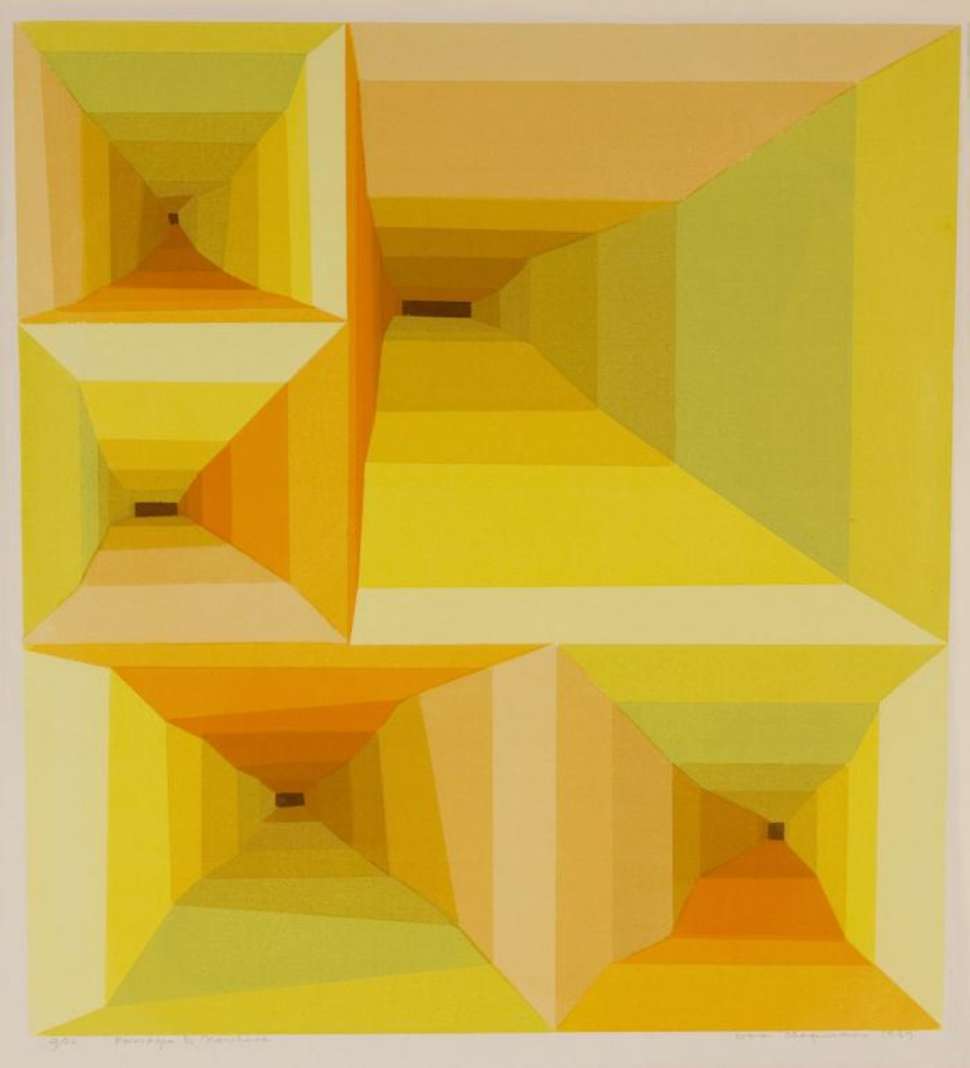Take 5
Dora Chapman
Dora Chapman (1911-1995) was a celebrated painter, printmaker, art teacher and, like her husband James Cant, a key figure in Australian art. She displayed an early artistic talent which saw her awarded a scholarship to attend the School of Arts and Craft in Adelaide, excelling in the areas of drawing, painting, modelling and needlework. Following graduation, she began to move away from ‘naturalism and superficial portraiture’, inspired by the impressionist and cubist methodologies of artists such as Cezanne, Degas and Picasso, she began to experiment with shapes, angles and application.
Much of Chapman’s life was dominated by her husband’s artistic pursuits, and she took on the role of ‘bread winner’ while maintaining her art practice on the side. Cant and Chapman were members of the Australian Communist Party and founding members of SORA (Studio of Realist Art) from 1945 to 1949 before they relocated to London. In 1955 the couple returned to Australia and settled briefly in Sydney before permanently moving to Adelaide where Chapman was offered a teaching position at the South Australian School of Art. She taught there until her retirement in 1969.
Flinders University Museum of Art’s small selection of works highlights Chapman’s achievement after her retirement, a period during which she was also caring for Cant who had been diagnosed with multiple sclerosis. Chapman worked fastidiously at her own practice, exploring new mediums such as screenprinting, ceramics and photography, while simultaneously assisting her husband to make art.
Madeline Reece
Exhibitions and Public Programs Manager, Flinders University Museum of Art
Adelaide, Australia, 2021
© Flinders University Museum of Art

Passages to nowhere 1969
screenprint, coloured inks on paper
43.4 x 40 cm, ed 4/22
Collection of Flinders University Museum of Art 2140
Unhappy with the inconsistent surface qualities of gouache and following her retirement from the South Australian School of Art (SASA) in 1969, now School of Art, Architecture and Design at UniSA City West, Chapman was gifted a silkscreen. This new medium drew on her artistic strength as it required meticulous planning and precise execution.
Passages to nowhere makes reference to the hard-edge abstraction influence popular in Adelaide during the mid-1960s and encouraged by her colleagues at SASA. However, Chapman’s work captures an intuitive and personal uptake of the movement. Here she employs this new style and medium to depict variations in hue for students at the North Adelaide School of Arts where she taught part time for a short period.

Aldinga 1970
screenprint, coloured inks on paper
38.1 x 30.5 cm, ed 5/33
Collection of Flinders University Museum of Art 2141
The 1970s became the most productive period in Chapman’s art practice. Prior to this she had not focused on art-making since she joined the Australian Women’s Army Service in 1942. Aldinga was created during this period when Cant and Chapman would travel for painting excursions.
At the time, Aldinga was a small settlement but is now a bustling suburb located forty-five minutes from the Adelaide city centre where the artists purchased a small holiday home. Chapman’s screenprint is a cubist landscape capturing the sand dunes and rare coastal vegetation of this unique ecosystem. Chapman had a keen interest in native flora and fauna and was a supporter of environmental conservation in the Willunga sub-basin region.

Dreaming girl 1970
screenprint, coloured inks on paper
38.4 x 28.1 cm, ed A/P
Collection of Flinders University Museum of Art 2142
Chapman’s foray into screenprint saw her practice shift away from social realist and landscape painting and return to her earlier interests of portraiture and figuration, most notably the depiction of female heads.
Dreaming girl captures Chapman’s natural talent for life drawing and portrayal of the human condition. Her nephew Richard Spoehr comments that Chapman ‘had almost an obsession with the human condition and importance of being in touch with one’s intellectual and emotional senses’. Each screenprint from this series displays a confident understanding of tone and colour to capture discrete human dispositions.

Katinka 1973
screenprint, coloured inks on paper
19.9 x 25.2 cm, ed 40/50
Collection of Flinders University Museum of Art 2143
Many of Chapman’s girls were based on people she had seen or met. Katinka was inspired by the daughter of Roy Dalgarno a close friend, artist and former member of SORA (Studio of Realist Art).
The semi-abstract, soft layers of burnt umber represent Katinka’s striking red hair, which initially caught Chapman’s attention. The artist strove to weave striking and individual characteristics with her designs to capture the essence of her subjects.

The kiln 1973
screenprint, coloured inks on paper
50 x 40 cm, ed 24/50
Collection of Flinders University Museum of Art 3429
The kiln also known as I See, was one the last screenprints Chapman created and was inspired by her ceramic making. She would throw pots and vessels for her husband Cant to decorate as he was wheelchair-bound following his multiple sclerosis diagnosis.
The radiating gradients of warm hues shift from a pale green to deep red and represent the sensation of peeking through the viewfinder of a working kiln. This abstraction of the interior of a kiln was created for inclusion in the University of Adelaide’s Bicentenary project in 1974.
Flinders University Museum of Art
Flinders University I Sturt Road I Bedford Park SA 5042
Located ground floor Social Sciences North building, Humanities Road adjacent carpark 5
Telephone | +61 (08) 8201 2695
Email | museum@flinders.edu.au
Monday to Friday | 10am - 5pm or by appointment
Thursdays | Until 7pm
Closed weekends and public holidays
FREE ENTRY
Flinders University Museum of Art is wheelchair accessible, please contact us for further information.


